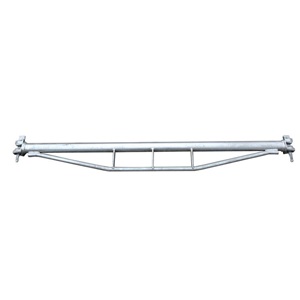What is Ledger in Scaffolding Exploring the Backbone of Structural Support
Aug 12, 2023
A ledger in scaffolding refers to a horizontal scaffold tube that runs parallel to the building's surface. It serves as a foundational element for constructing scaffolding systems. Ledgers are positioned at right angles to the standards (upright vertical posts) and provide lateral support to the scaffold structure. These components are crucial in maintaining the stability and integrity of the scaffold, ensuring the safety of workers and the successful execution of construction projects.
There are two primary types of ledgers commonly used in scaffolding:
The steel scaffolding single ledger, also known as a standard ledger, is a horizontal tube that spans the distance between two adjacent standards. It provides support and stability to the scaffold by connecting the vertical standards on each side.
A steel scaffolding double ledger, on the other hand, is a horizontal tube that spans the distance between two standards but is also supported by ledgers beneath it. This configuration allows for increased load-bearing capacity and is particularly useful when heavier materials need to be supported on the scaffold.

Steel: Steel ledgers are highly popular due to their strength and durability. They can withstand significant loads, making them ideal for larger or more complex scaffolding systems. However, they are also heavier than other materials, which can increase labor and transportation costs.
Aluminum: Aluminum ledgers are lighter and easier to handle compared to steel. While they may not offer the same level of strength as steel, they are corrosion-resistant and well-suited for environments where scaffolding needs to be frequently moved or adjusted, such as in renovation or temporary projects.
Timber: Timber ledgers are sometimes used in traditional scaffolding setups, but they are increasingly rare due to modern safety regulations and material advancements. Timber ledgers offer flexibility but may lack the durability and consistency of steel or aluminum.
The functions of ledgers in scaffolding are multifaceted and integral to the overall stability and safety of the structure. Some key functions include:
The utilization of ledgers in scaffolding offers several advantages:
Given the crucial role that ledgers play in the structural integrity of scaffolding, their proper installation and maintenance are essential for job site safety. Scaffolding accidents, many of which involve improper assembly or load distribution, can lead to serious injuries or even fatalities. Therefore, understanding the safety aspects of ledgers is critical for construction teams.
Proper Installation
Regular Inspections
Load Limits
In the realm of scaffolding, the significance of ledgers cannot be overstated. As horizontal support beams, ledgers play a pivotal role in maintaining stability, ensuring safety, and facilitating efficient construction processes. By understanding the role, types, installation, and advantages of ledgers, construction professionals can elevate their projects to new heights of safety and excellence.
Ledgers are primarily used horizontally to provide lateral support. However, they can also be used diagonally to enhance scaffold stability in certain situations.
Ledgers are often made from steel or aluminum, providing durability and strength while remaining lightweight.
Yes, high-quality ledgers can be reused for multiple construction projects, as long as they remain in good condition and pass safety inspections.
Ledgers are compatible with various scaffolding systems, including tube and coupler scaffolds, ring-lock scaffolds, and cup-lock scaffolds.
Absolutely, ledgers can be used in both indoor and outdoor construction projects, adapting to the specific requirements of the environment.
Safety Alert For Scaffolding Components -- HSA
Different Types Of Scaffolding Components And Types -- CONSTROFACILITATOR
Scaffolding Safety and Compliance -- FACILITIES